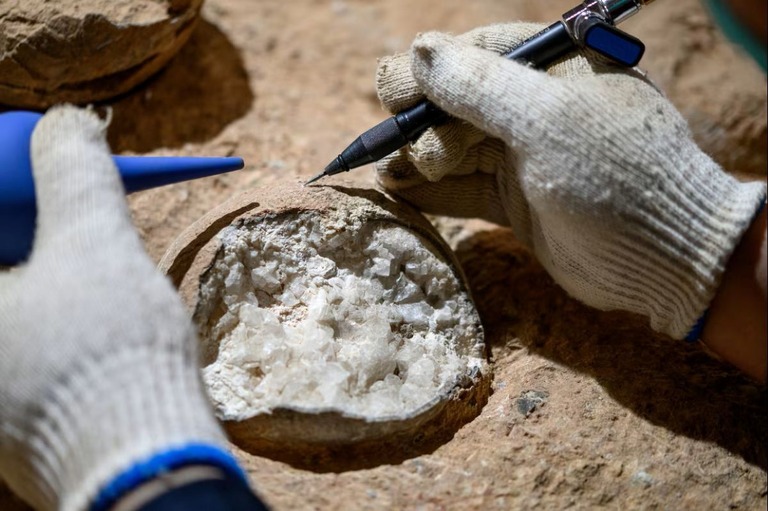中国の
青龍山化石保護区で、28
個の
恐竜の
卵が
見つかりました。
28 dinosaur eggs were discovered in the Tanglong Mountain Fossil Protection Zone in China.
たちは「
原子時計」とも
言われる
特別な
方法で、この
卵の
年れいを
調べました。
Scientists used a special method called an atomic clock to determine the age of these eggs.
その
結果、これらの
卵は
約8600
万年前のものだと
分かりました。
The results indicate that these eggs are about 86 million years old.
この
方法は「ウラン
鉛年代測定法」と
呼ばれます。
This method is called the uranium-lead dating method.
の
殻にはウランという
物質があり、
長い
時間がたつとウランは
鉛に
変わります。
Uranium is a substance contained in eggshells, and over a long period of time, uranium transforms into lead.
たちはレーザーで
卵の
殻をすこしけずり、ウランと
鉛の
量を
調べました。
Scientists used lasers to gently shave the eggshells and examined the amounts of uranium and lead.
その
比率から、
卵がどれくらい
古いか
分かります。
From this ratio, they can determine the age of the eggs.
この
方法で
恐竜の
卵の
年れいを
正確に
知ることができたのは、
青龍山化石保護区では
初めてです。
This is the first case in which the age of dinosaur eggs has been accurately determined by this method in the Tainlongson Fossil Reserve.
この
保護区には、
他にもたくさんの
卵が
有りますが、まだどの
恐竜が
産んだかは
分かっていません。
There are many other eggs in this sanctuary, but it is still unknown which dinosaurs laid them.
はすこし
平らな
丸い
形で、
長さは120~170ミリメートル、
殻の
厚さは2.4ミリメートルです。
The eggs are somewhat flat and oval-shaped, measuring 120 to 170 millimeters in length, with a shell thickness of 2.4 millimeters.
たちは、この
研究で
恐竜が
昔の
寒い
気候にどうやって
生きていたかを
知る
手がかりになると
考えています。
Scientists believe that this research will help find clues about how dinosaurs lived in the once cold climate.
また、この
新しい
方法を
使えば、
世界中の
恐竜の
卵の
年れいも{もっと}
正確に
分かるようになるかもしれません。
Furthermore, by using this new method, we can determine the ages of dinosaur eggs around the world more accurately.











